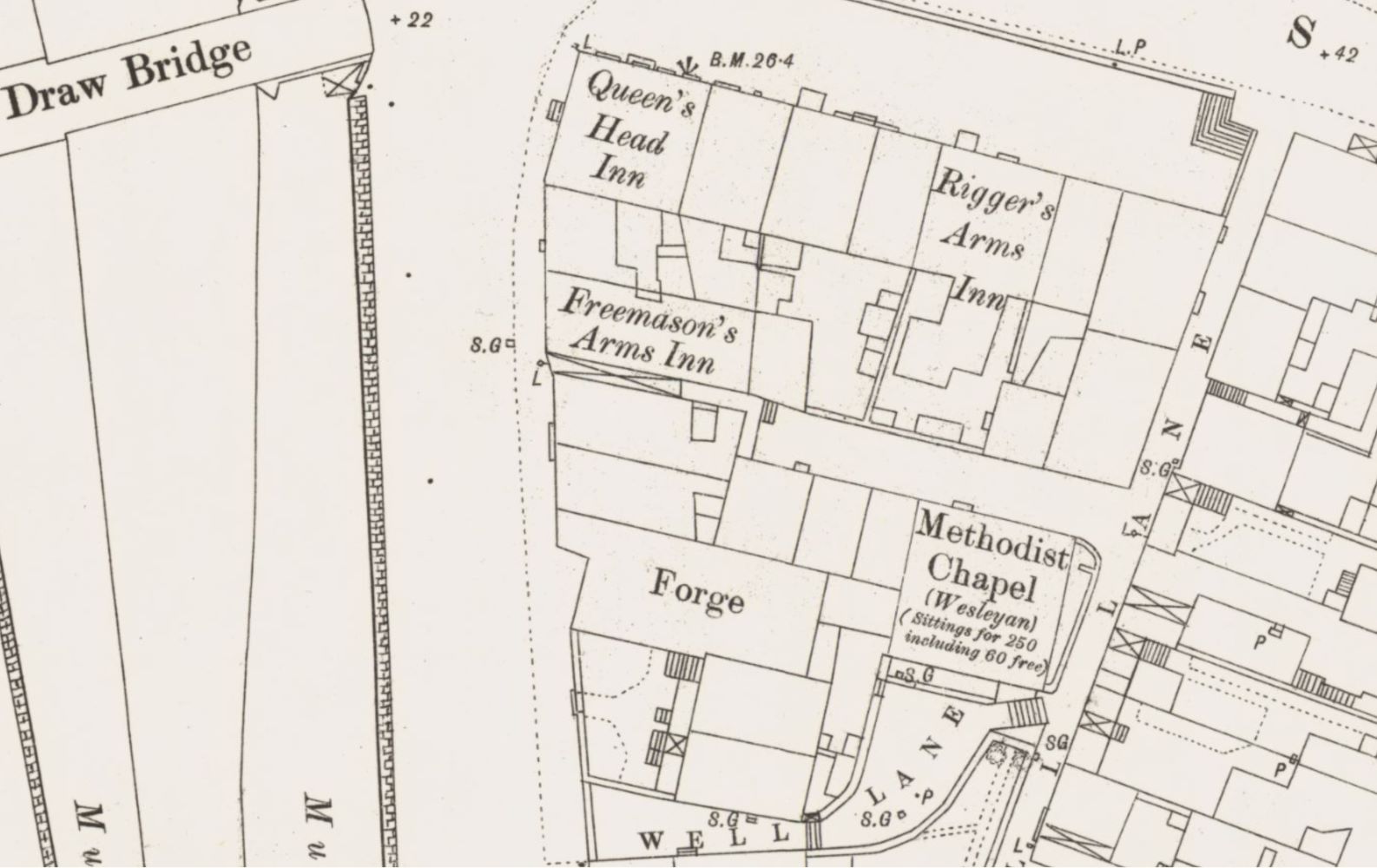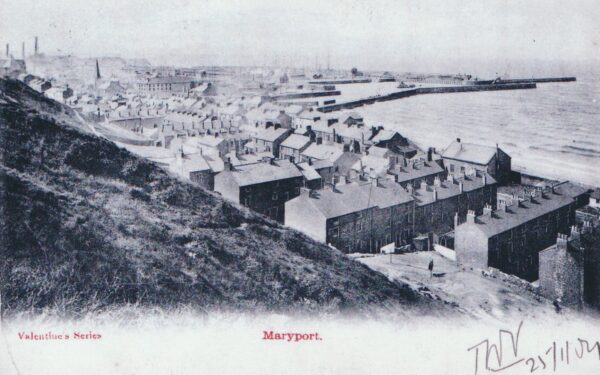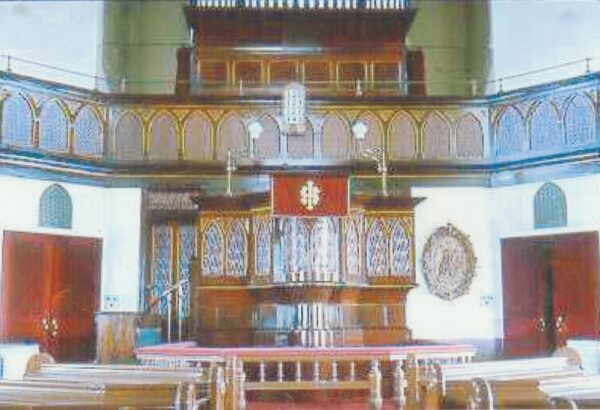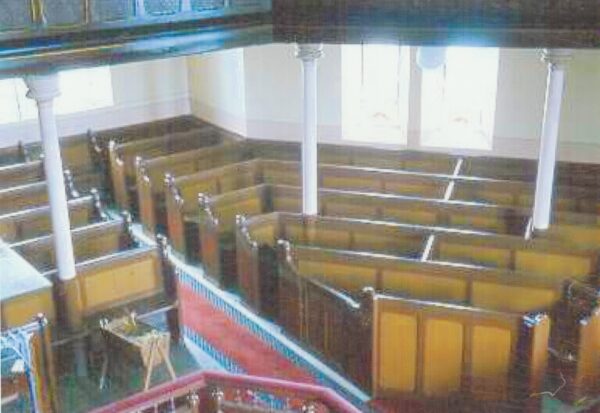Methodist Churches of Back Brow Street and Well Lane
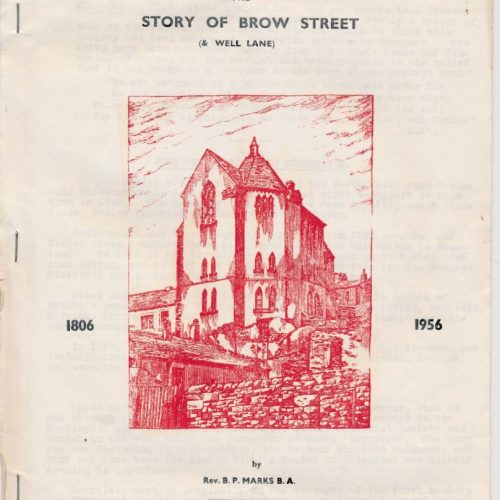
Back Brow in Early Days
The streets were lighted only by candles and oil lamps. David Beck the local police constable, was a noted character who, having lost a hand in the wars, had in its place an iron hook. He used to chain his prisoners to the fire grate in his house until morning when, with the assistance of his friend, Timmy Banks. a tinker and amateur lawyer he disposed of the cases over a pot of ale and a few pinches of snuff.
A lock up was later provided and it was a sort of dungeon, which was excavated in the side of the Brow below Kirkby Street. If one looks at the supporting wall in Brow Street one can still see the stone side posts and lintels of its doorway.
At the foot of Back Brow. on the right. stood the Back Brow Pump. one of the principal water supplies of the town. This famous relic was commemorated by Frederick Cawthorne as follows:
A time honoured trump was the Back Brow Pump
In the light of the wall that stood,
Where damsels all weather would group together,
In turns for water good.
Not only the girls of the Market Square.
And of Oakum Bay each belle.
The jolly young mariners all drew there
With Pat and his key at the well,
Creaking, Chattering, thump on thump.
By day and by night went the old town pump
The newly built Brow Street Methodist Chapel had its opening service on July 17th 1864. The chapel is situated at the north end of the Old Brewery Steps leading to Nelson Street. The land was purchased for £160 and the chapel cost £1,350 to build. It had seating for 375 people. The former Wesleyan Chapel in Well Lane, which the new chapel replaced, was sold the following year for £239.
Extract from The Maryport Walkabout by Herbert and Mary Jackson (Geoff B collection)
Let’s go down Brow Street keeping on the right hand side. Look across to the other side of the road after you pass the last house and you will see the remains of what was once a fine octagonal shaped Methodist Church. It was in this church that Kathleen Ferrier gave her first concert in Maryport. Visitors from across the other side of the Solway may recall that shortly after Maryport Methodists stopped using this building for worship, it was burned out and the glare from the flames could be seen across the other side of the Solway Firth.
Now keeping to the right hand side you will arrive at a stone wall topped by a grassy bank. Be on the alert, for in that stone wall just about 15 yards from the last house one can still see the stone side posts and lintels of a doorway. This was the town’s first gaol used in the early 19th century.
Going down the hill, at the foot of the Back Brow, on the right stood the Back Brow pump, one of the principal water supplies of the town in the days when the majority of the town lived in the area known as Down Street, along the flat land close to the shore. – end of extract
Maryport Methodists – The Story of Brow Street and Well Lane
1806 – 1956
by Reverend BP Marks 19th February 1956
John Wesley comes to Cumberland
During his numerous visits to the Northwest, John Wesley made Whitehaven his headquarters, his first visit being paid to that town in 1749. The Methodist Society there grew rapidly and two years later Wesley reported 240 members in Whitehaven.
Cockermouth was also frequently visited from 1751 onwards, and Wesley often preached there as he travelled from Whitehaven to Scotland. We read of him travelling from Cockermouth on to Wigton and then setting out to Ford the Solway Firth at low tide in the Bowness area and so riding on to Dumfries and the north.
Other nearby places mentioned in his journal as the scenes of Wesley’s preaching are Hensingham in 1749, Workington in 1761, Carlisle, Keswick, Lorton, Clifton, Seaton, Branthwaite and Ballantyn which may be Tallentire. [The Ballantyne Dykes family were major land owners ]
In 1769 the ‘Whitehaven Circuit’ was formed. It was immense and included Carlisle Maryport Workington Ulverston Kendal Penrith and even the Isle of Man.
Origins of the Maryport Society
These lie in obscurity but we can be sure however that it was through the faithful witness of the Methodist preachers in the Workington and Cockermouth areas that a little Methodist Society was formed in the town which had just been renamed Maryport. The town was now beginning to grow rapidly, the harbour had been enlarged and what had once been the little fishing hamlet of Ellenfoot was quickly growing in important.
Doubtless meeting originally in the cottages of the first members the Methodist Society eventually became strong enough to start making plans for the erection of a place of worship.
The first Chapel is built
A site was obtained in Well Lane and the first Methodist Chapel was built by Mr. Martin, a forebear of Mrs Long, one of the present trustees of Brow Street reet. It was opened in 1806. Well Lane was at that time called Summer House Lane because Mr Humphrey Senhouse the Squire had built a summer house on the brow of the hill there from which he could watch the development of the harbour.
There was a debt of £250 pounds on the new Chapel a debt that was not cleared until the building was sold nearly 60 years later. But the Society flourished and within a dozen years the Chapel could not adequately accommodate the congregation. To relieve the problem a gallery was installed in 1818. By this time Summerhouse Lane had became known as “Methody Lane”.
Finances of the Well Lane Society
There is no record preserved of the earliest accounts of the Society, but the Society stewards book and the trust treasurer’s accounts from 1849 can be consulted and these reveal some interesting facts.
- Collections in that year averaged 1 shilling 8 pence per Sunday.
- Pew rent varied greatly according to the position of the seat, those in the gallery varied from 9 pence to three shillings per quarter, those in the body of the chapel from 9 pence to five shillings.
- In 1849 the Chapel keeper received 9 pence a week.
- The year’s gas bills totalled 13 shillings.
In 1852 there were three class leaders having the oversight of the Society James Corson, William Parker and Andrew Smith.
An entry in the treasurer’s book dated February 22nd 1853 suggests that Maryport Methodists were still financially embarrassed. It reads “8 old boxes for repairing floor of Chapel 7 shillings 8 pence.”
It was a constant struggle against debt, and when in 1855 it was necessary to appoint new trustees no one was very anxious to join the trust board for the Chapel debt was £251 pounds. The Reverend Joseph Watson Chairman of the Carlisle district wrote the following in the Maryport Trust treasurers accounts book.
“This is to certify that in consequence of the death of all the trustees of the Wesleyan Methodist Chapel and other property in Maryport in the Wigton circuit, except one, it was resolved to form a new trust forthwith. This however necessary as it was in order to retain the property, was found impracticable unless the debt upon the property, which had accumulated to 251 pounds was reduced to 200 pounds. In order to effect this desirable object the friends at Maryport raised the sum of 31 pounds which was met by a sum of £20 from the Chapel Relief Fund and thus reducing the debt to 200 pounds. He knew trust was at once formed consisting of the one surviving trustee Mr Philip crane of Whitehaven and ten others.”
But if the path was hard as far as their Chapel finances were concerned, these Methodists of 100 years ago had a wider vision and gave liberally for the work of Foreign Missions.
In 1857 out of the Wigton circuits total of £34 6 8d the Well Lane Society contributed no less than £13 pounds.
In 1857 the musical side of the church worship received some attention and one wonders if it was in this year that the tuning fork gave place to the organ. The accounts show purchase of a hymn book with tunes. The following year the first organist was officially appointed
Mr John Dixon and was to receive 3 pounds per year. In order to meet this new expense it was agreed that an annual collection be taken for the organist, any deficiency being made-up from church funds. The first such collection was taken on the night of October 13th 1861. The organist received £1 5 shillings 1½ pence.
Hopes of a better Chapel
A significant item of expenditure occurs in the Ledger for 1862 when on April 7th 6 shillings was paid for a report respecting the possibility of the erection of a new Chapel. On December 27th £43 was set aside towards the purchase of a new site.
Brow Street Chapel is built
In 1863 a formal application was made to the Methodist Chapel committee for permission to build a new Chapel with a better situation and more commodious premises. Estimated cost was £1,682 pounds. The trustees confessed that their Well Lane Chapel was still £200 pounds in debt but said they hoped to raise £300 pounds from its sale.
Permission to go ahead was granted and a grant of £50 pounds made towards the cost of the Chapel but it was stated that on no account must the new Chapel cost more than £1,305 pounds in view of the financial position of the Society.
The trustees had to agree to raise as much money as possible from pew rents in the new Chapel but 53 seats must always be kept for the poor and these seats must have comfortable backs and be situated in such a place that the preacher could be easily seen and heard!
In 1864 (the year in which the minister’s allowance was increased from £60 to £65 per year) a plot of land was purchased from Henry Kenyon for £160. Situated on the north side of the Old Brewery steps and with a frontage of 43 yards the only building on the site at that time was a stable.
Estimates were obtained for the work on the new Chapel and a record of the tenders received has been preserved which are
Mason and brickwork tenders varied £408 – £445
Joiners work tenders varied £420 – £488
Plasterers work estimate £46
Slater’s work tenders varied £49 to 82
Plumbing painting glazing from £94 to £135
Anxious to begin work on the new Chapel the trustees immediately borrowed £900, £600 from the Carlisle Union Bank and the other privately this was all repaid within 12 months!
Brow Street Chapel is paid for – cost £1350
The total cost of the Chapel £1350 was only £45 in excess of the expected figure. It had seating accommodation for 375 people and an interesting feature was its glass roof. The preacher entered the pulpit not up steps from the vestry but through a door in the back of the pulpit.
The members of the Society worked hard and gave freely towards the cost of their new church. Within a period or nine months 2 bazaars were held bringing in £132 and £49 respectively. The stone laying ceremony raised £24 and the subscription list totalled over £1,040. At the opening services the collections amounted to £52. By August 1871 the new church was entirely free of debt.
The first services were held in Brow Street on Sunday July 17th 1864.
Well Lane Chapel sold for £239
In the following year, 1865, the old Well Lane Chapel was sold to J Guy Esq of Workington for £239 (the trustees failed to get their expected £300). The old Chapel soon became a lodging house and has since been turned into a dwelling house still bearing on its front wall the date 1806. [written in 1956 since then demolition and new flats]
The membership of the Society was at this time 76 with an average of about 140 hearers.
Income of the new church
In 1865 the first full year of the church life Pew rents brought in £27 13 shillings 9 pence while the total collections for the year were £12 pounds one shilling and half of a penny. Sunday collections had risen from under 4 shillings per week in the last year of Well Lane Chapel to nearly five shillings in the first year at Brown Street. Total expenditure for 1865 was £51 !
In 1876 a new source of income appears – rent for stable £5.
But our Methodist forebears showed an even keener business sense when we find the treasure reporting in 1862 income from posting bills on stable door Mr. T Walker 2 shillings and six pence.
Church work progresses
The Brow Street Society was going ahead. In 1882 we have the first mention of the “Young Men’s Mutual Improvement Class” and in 1889 the Band of Hope was firmly established. The Chapel anniversary was the highlight of the church year and it is significant that the anniversary celebrations raised as much money for the church as the ordinary collections for the rest of the year.
In 1897 an application was made to the Chapel committee for permission to build an additional classroom, parlour, ladies room and kitchen at an estimated cost of £400. Mrs Mrs J & B Williamson have kindly promised to pay for this extension to the premises.
At the same time extensive alterations were made to the church a new roof ceiling windows etc were put in and the present organ installed. Again Mrs J & B Williamson paid for these alterations and for the organ through their kindness relieving the church of what would have been a very heavy debt.
The membership of the Society steadily increased between 1891 and 1899 growing from 60 members to 77 the highest membership the church has had. In 1901 an evangelistic enterprise led to a 14 day special mission at the church and large crowds attended the meetings each evening.
After the end of May 1902 the church lost a faithful organist in the passing of Mr Daniel Dixon who had held this post for 37 years. A plaque was placed on the organ in his memory. The trustees appointed Mr J Baxter to succeed him in the appointment.
Clear Broughton Moor of their Debt
In 1906 a new board of Trustees was appointed and an interesting record in the trust minutes at this time refers to the newly built Chapel at Broughton Moor. This small Society had worked hard for the election of their new Wesley church none the expense had been a heavy burden on them. In 1907 the Brow Street trustees voted a donation of £10 to Broughton Moor that the remaining debt on their Chapel might be cleared !
Work of the ladies of the church
Like most churches Brow Street has owed a great debt over the years to the ladies of the congregation who have organised Sales of Work etc for the benefit of the church funds. 1906 just 50 years ago their annual sale of work realised £16 and a total of £78 was held in their funds for the church use.
On November 7th 1915 the ladies of the church met to make arrangements for their forthcoming Christmas sale. They make the following appointments
Refreshments stall Mrs Shannon Mrs Dixon Mrs downer Mrs Hardy Mrs Kelly Miss Cobain.
Christmas tree Mrs Benson and Edmonton Mr Irving was asked to decorate the room and Mr Hicks to arrange a musical programme for the evening of the sale the proceeds of the sale were £21 pounds 13 shillings. The rummage sale in the same year realised £4 four shillings. By 1924 the income from the Christmas sale of work had risen to £72 pounds. In recent years it has rarely been less than £100.
Special preachers
Many distinguished preachers have occupied the Brow Street pulpit Mr Dinsdale Young paid his first visit for the Chapel anniversary on March the 8th 1915 and he came again in 1920 and in 1928 on the last occasion taking as his subject 50 years a preacher. In 1922 and 1924 the special preacher for the Chapel anniversary services was Rev W Hannon BD of the Edinburgh mission and large congregations attended on both these occasions.
Evangelistic mission 1925
A 15 day special mission was conducted in Brow Street by Reverend Jean Courtney of Wigton. It commenced on January 25th meetings were held every evening and a special men’s meeting on Sunday afternoon February the first. So great was its success that the mission was prolonged for a further five days there were two meetings on the Saturday night. At the first Miss Skelton being the soloist and her sister the organist.
The second meeting commenced at 10:00pm some who had not been inside a church for years were present and one of the converts before she would let the minister pray with her asked him to go from the vestry into the church and fetch a bottle of ale she had left there in the pew. He was to throw it away for she wanted to commence an entirely new life.
Large numbers of people throughout the mission flocked to the communion rail to re-consecrate their lives to Christ and his church. Many open air meetings were held and Mr George Ritson of Dearham rendered invaluable service throughout by his house to house visitation. Throughout the mission Mr W Brinicombe was organist. Mr Courtney visited all the towns public houses during the fortnight distributing literature and inviting those present to the Brow Street mission.
Miss Kathleen Ferrier
In 1937 Kathleen Ferrier sang for the first time in Brow Street. This was of course before she reached the height of her brilliant career terminated so recently by her untimely death. It was a week before Christmas on December 17th and she took solo parts in Handel’s Messiah being given that evening by an augmented choir.
Presentations to the church
In 1940 Miss Williamson of Solway Villa, Crosby presented to the church 3 carved plaques, the work of her late father Mr Henry Wiliamson. They portrayed ‘The Descent From The Cross’, “The Lords Prayer” and “O God Our Help in Ages Past”. These were gladly received and hung in an honoured place in the church.
Wartime – The Ladies Working Party
During the 1939 two 45 war the Ladies Working Party gave splendid service raising large sums of money for the Red Cross, Maryport Central Comforts Fund the RNLI the Merchant Navy Methodist War Emergency Fund, National Children’s Home and Orphanage, and the funds of Brow Street itself.
Mrs Ward, who opened the 1942 Christmas sale, herself a member of the Working Party, told the assembled company how the Working Party came into being. She said that at the time of its inauguration a number of the Brow Street ladies were working alone at home for the Comforts Fund. They decided to meet together for this work at Brow Street and materials were received for making up from the WVS Mrs Crone agreed to help with the cutting out of the material, and soon garments were going out to bombed areas, to Russia, to prisoners of war in Germany, and to the local hospital.
A most successful arts and crafts exhibition was also organised by the working party in 1942.
On June the 2nd 1945 the working party officially closed down it had done a splendid piece to of service to both the community as a whole and to the church on whose premises it met.
The officials in 1945 were president Mrs Crone treasurer Mrs Huggins secretary Mrs F Clark.
Circuit changes
In 1949 changes were made in the boundaries of some of the West Cumberland Circuits and as a result of these the old Maryport and Wigton Circuit was split up. Brow Street lost its happy contact with the Wigton and Aspatria churches and with those little villages of Caldbeck, Fletchertown, Abbeytown, Heskett Newmarket and the rest.
By reason of its longer history Brow Street became the first church on the new amalgamated Maryport Circuit Plan. The new Circuit was composed of the Maryport section of the Maryport and Wigton Circuit and the ex-Primitive Methodists “Maryport” Circuit.
Doctor Sangster at Brow Street
In 1950 Doctor Sangster then President of the Methodist Conference came to the Maryport circuit and the afternoon service in the Brow Street brought a large crowd and a full church. Tea followed in the schoolroom, each church in the circuit being responsible for one table. The evening meeting was held in Trinity Baptist Church and a capacity crowd filled this church which, alas, was shortly afterwards declared unsafe and had to be demolished.
Electric organ blower installed
For many years the trustees had been thinking of installing an electric organ blower. Early in 1955 as a result of a talents scheme in which nearly all the members of the congregation took part the necessary money was raised and the organ blower installed.
{Ed: Before the electric blower, a hand pumped bellows would be used, when he was a child, my father used to pump the bellows at our old church. PN}
1956 our Third Jubilee
Now we celebrate our 150th anniversary. Our church has had a long and proud history and God has been great and worthy servants here in pastures. We approach our Third Jubilee with a deep sense of thankfulness for the way we have been led. What the future will bring will depend upon him and upon us there is no more appropriate prayer for us at this time than:-
Made the shadow of Thy presence around our camp be spread ;
Baptise us with the courage Thou gavest to our dead ;
O keep us in the pathway the saintly feet have trot ;
for the might of Thine arm we bless Thee, our God, our fathers’ God.
Ministers Of The Maryport Society, 1854-1956
Well Lane
1854-6 John Hooton
1856-7 Peter Wilkinson
1858-9 R S Coe
1859-60 Richard Crookall
1 860-1 Francis Hewitt
1861-4 W M Kidman.
Brow Street
1864-6 Henry Gibson.
1866-8 John S Robinson
1868-70 Thomas Hargreaves
1870-1 Silas Jones
1871-2 Thomas A Seed
1872-5 Samuel Adcock
1875-6 Frederick Law
1876-8 Thomas Rodham
1878-81 James Duff
1881-82 Henry Needle
1882-5 J. Bunting
1885-7 Stephen G. Scott
1887-90 Charles Bingant
1891-3 William Pallister
1893-6 John G. Winter
1896-1900 James Duff
1900-02 J W Keyworth
1902-04 Josiah Tollady
1904-07 Henry Marchbank
1907-10 T R Jackson
1910-12 Frederick Law
1912-14 Ebenezer Edwards
1914-15 Edgar Bradford
1915-18 Robert Lloyd Jones
1918-21 S F Pawson
1921-23 Fred A Smith
1923-27 W J Hannam
1927-30 Charles A Harries
1930-33 Clifton S Winter
1923-36 Robert Watkins
1936-39 W Benjamin Charles
1939-44 Edmund S Harland
1944-49 Joseph E Knox
1949-52 John P Monkhouse
1952-56 Bernard P Marks
Editor’s note: This was in a box of delights from a Maryport local who wishes to remain anonymous . The box contained hundreds of photos and pages of documents relating to Maryport and area. I digitised the items and converted the text from being on paper to being on screen, where you can change the size of the font to make it readable. I sometimes highlight bits of text that I find interesting that I may extract to use when I give talks. If you use Microsoft Edge to view pages then you will find an icon that will read the page out aloud !
Photos have been scanned and digitised and the colours changed and the borders removed and the title made as appropriate as possible.
If you can help to identify items in the photos then please email me with your information that I can add to give more meaning to the picture. Some text attached to photos is from books that are acknowledged in the “About” section or in the photo text.
Please, if you can add other information about the text or pictures then contact me.
Peter Nicholson Editor October 2023

